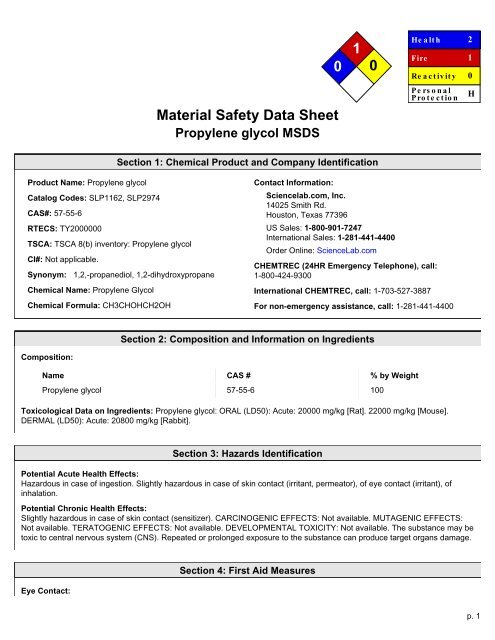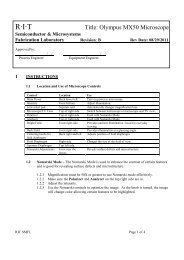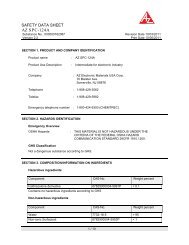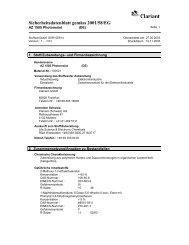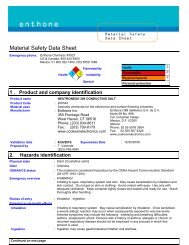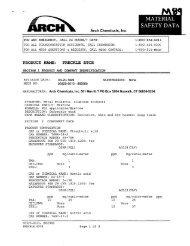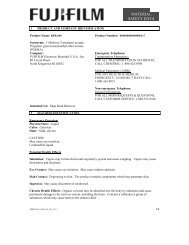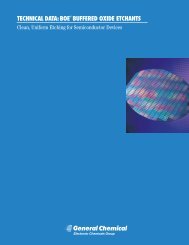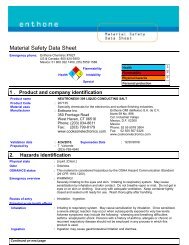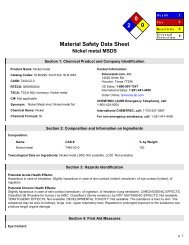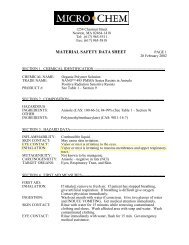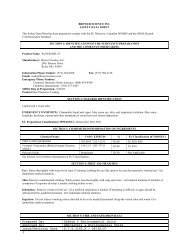1 0 0 Material Safety Data Sheet - SMFL
1 0 0 Material Safety Data Sheet - SMFL
1 0 0 Material Safety Data Sheet - SMFL
- No tags were found...
You also want an ePaper? Increase the reach of your titles
YUMPU automatically turns print PDFs into web optimized ePapers that Google loves.
<strong>Material</strong> <strong>Safety</strong> <strong>Data</strong> <strong>Sheet</strong>Propylene glycol MSDS10 0He a lt hFireRe a c t iv it yPe rs o n a lPro t e c t io n210HSection 1: Chemical Product and Company IdentificationProduct Name: Propylene glycolCatalog Codes: SLP1162, SLP2974CAS#: 57-55-6RTECS: TY2000000TSCA: TSCA 8(b) inventory: Propylene glycolCI#: Not applicable.Synonym: 1,2,-propanediol, 1,2-dihydroxypropaneChemical Name: Propylene GlycolChemical Formula: CH3CHOHCH2OHContact Information:Sciencelab.com, Inc.14025 Smith Rd.Houston, Texas 77396US Sales: 1-800-901-7247International Sales: 1-281-441-4400Order Online: ScienceLab.comCHEMTREC (24HR Emergency Telephone), call:1-800-424-9300International CHEMTREC, call: 1-703-527-3887For non-emergency assistance, call: 1-281-441-4400Section 2: Composition and Information on IngredientsComposition:Name CAS # % by WeightPropylene glycol 57-55-6 100Toxicological <strong>Data</strong> on Ingredients: Propylene glycol: ORAL (LD50): Acute: 20000 mg/kg [Rat]. 22000 mg/kg [Mouse].DERMAL (LD50): Acute: 20800 mg/kg [Rabbit].Section 3: Hazards IdentificationPotential Acute Health Effects:Hazardous in case of ingestion. Slightly hazardous in case of skin contact (irritant, permeator), of eye contact (irritant), ofinhalation.Potential Chronic Health Effects:Slightly hazardous in case of skin contact (sensitizer). CARCINOGENIC EFFECTS: Not available. MUTAGENIC EFFECTS:Not available. TERATOGENIC EFFECTS: Not available. DEVELOPMENTAL TOXICITY: Not available. The substance may betoxic to central nervous system (CNS). Repeated or prolonged exposure to the substance can produce target organs damage.Eye Contact:Section 4: First Aid Measuresp. 1
Precautions:Keep away from heat. Keep away from sources of ignition. Empty containers pose a fire risk, evaporate the residue under afume hood. Ground all equipment containing material. Do not ingest. Do not breathe gas/fumes/ vapor/spray. Wear suitableprotective clothing. In case of insufficient ventilation, wear suitable respiratory equipment. If ingested, seek medical adviceimmediately and show the container or the label. Avoid contact with skin and eyes. Keep away from incompatibles such asoxidizing agents, reducing agents, acids, alkalis, moisture.Storage:Hygroscopic. Keep container tightly closed. Keep container in a cool, well-ventilated area. Do not store above 23°C (73.4°F).Section 8: Exposure Controls/Personal ProtectionEngineering Controls:Provide exhaust ventilation or other engineering controls to keep the airborne concentrations of vapors below their respectivethreshold limit value. Ensure that eyewash stations and safety showers are proximal to the work-station location.Personal Protection:Splash goggles. Lab coat. Vapor respirator. Be sure to use an approved/certified respirator or equivalent. Gloves.Personal Protection in Case of a Large Spill:Splash goggles. Full suit. Vapor respirator. Boots. Gloves. A self contained breathing apparatus should be used to avoidinhalation of the product. Suggested protective clothing might not be sufficient; consult a specialist BEFORE handling thisproduct.Exposure Limits:TWA: 10 (mg/m3) from AIHA Consult local authorities for acceptable exposure limits.Physical state and appearance: Liquid. (Oily liquid.)Odor: Practically Odorless.Taste: Practically Tasteless.Molecular Weight: 76.1g/moleColor: Colorless. ClearpH (1% soln/water): Not available.Boiling Point: 188°C (370.4°F)Melting Point: -59°C (-74.2°F)Critical Temperature: Not available.Specific Gravity: 1.036 (Water = 1)Vapor Pressure:0 kPa (@ 20°C) 0.08 mmHg at 20 C 0.129 mmHg at 25 CVapor Density: 2.62 (Air = 1)Volatility: Not available.Odor Threshold: Not available.Section 9: Physical and Chemical PropertiesWater/Oil Dist. Coeff.: The product is more soluble in water; log(oil/water) = -0.9Ionicity (in Water): Not available.Dispersion Properties: See solubility in water, acetone.p. 3
Solubility: Soluble in cold water, hot water, acetone.Stability: The product is stable.Instability Temperature: Not available.Section 10: Stability and Reactivity <strong>Data</strong>Conditions of Instability: Incompatible materials, excess heat, exposure to moist air or waterIncompatibility with various substances: Reactive with oxidizing agents, reducing agents, acids, alkalis.Corrosivity: Non-corrosive in presence of glass.Special Remarks on Reactivity:Hygroscopic; keep container tightly closed. Incompatible with chloroformates, strong acids (nitric acid, hydrofluloric acid),caustics, aliphatic amines, isocyanates, strong oxidizers, acid anhydrides, silver nitrate, reducing agents.Special Remarks on Corrosivity: Not available.Polymerization: Will not occur.Routes of Entry: Absorbed through skin. Eye contact.Section 11: Toxicological InformationToxicity to Animals:Acute oral toxicity (LD50): 18500 mg/kg [Rabbit]. Acute dermal toxicity (LD50): 20800 mg/kg [Rabbit].Chronic Effects on Humans: May cause damage to the following organs: central nervous system (CNS).Other Toxic Effects on Humans:Hazardous in case of ingestion. Slightly hazardous in case of skin contact (irritant, permeator), of inhalation.Special Remarks on Toxicity to Animals: Not available.Special Remarks on Chronic Effects on Humans:May affect genetic material (mutagenic). May cause adverse reproductive effects and birth defects (teratogenic) based onanimal test data.Special Remarks on other Toxic Effects on Humans:Acute Potential Health Effects: Skin: May cause mild skin irritation. It may be absorbed through the skin and cause systemiceffects similar to those of ingestion. Eyes: May cause mild eye irritation with some immediate, transitory stinging, lacrimation,blepharospasm, and mild transient conjunctival hyperemia. There is no residual discomfort or injury once it is washedaway. Inhalation: May cause respiratory tract irritation. Ingestion: It may cause gastrointestinal tract irritation. It may affectbehavior/central nervous system(CNS depression, general anesthetic, convulsions, seizures, somnolence, stupor, musclecontraction or spasticity, coma), brain (changes in surface EEG), metabolism, blood (intravascular hemolysis, white bloodcells - decreased neutrophil function), respiration (respiratory stimulation, chronic pulmonary edema, cyanosis), cardiovascularsystem(hypotension, bradycardia, arrhythmias, cardiac arrest), endocrine system (hypoglycemia), urinary system (kidneys),and liver. Chronic Potential Health Effects: Skin: Prolonged or repeated skin contact may cause allergic contact dermatitis.Ingestion: Prolonged or repeated ingestion may cause hyperglycemia and may affect behavior/CNS (symptoms similar to thatof acute ingestion). Inhalation: Prolonged or repeated inhalation may affect behavior/CNS (with symptoms similar to ingestion),and spleenSection 12: Ecological InformationEcotoxicity:Ecotoxicity in water (LC50): >5000 mg/l 24 hours [Goldfish]. >10000 mg/l 48 hours [guppy]. >10000 mg/l 48 hours [water flea].BOD5 and COD: Not available.p. 4
Products of Biodegradation:Possibly hazardous short term degradation products are not likely. However, long term degradation products may arise.Toxicity of the Products of Biodegradation: The products of degradation are less toxic than the product itself.Special Remarks on the Products of Biodegradation: Not available.Waste Disposal:Section 13: Disposal ConsiderationsSection 14: Transport InformationDOT Classification: Not a DOT controlled material (United States).Identification: Not applicable.Special Provisions for Transport: Not applicable.Section 15: Other Regulatory InformationFederal and State Regulations:Pennsylvania RTK: Propylene glycol Minnesota: Propylene glycol TSCA 8(b) inventory: Propylene glycolOther Regulations: EINECS: This product is on the European Inventory of Existing Commercial Chemical Substances.Other Classifications:WHMIS (Canada): Not controlled under WHMIS (Canada).DSCL (EEC):R21/22- Harmful in contact with skin and if swallowed. S24/25- Avoid contact with skin and eyes.HMIS (U.S.A.):Health Hazard: 2Fire Hazard: 1Reactivity: 0Personal Protection: hNational Fire Protection Association (U.S.A.):Health: 0Flammability: 1Reactivity: 0Specific hazard:Protective Equipment:Gloves. Lab coat. Vapor respirator. Be sure to use an approved/certified respirator or equivalent. Splash goggles.Section 16: Other InformationReferences:-Hawley, G.G.. The Condensed Chemical Dictionary, 11e ed., New York N.Y., Van Nostrand Reinold, 1987. -SAX, N.I.Dangerous Properties of Indutrial <strong>Material</strong>s. Toronto, Van Nostrand Reinold, 6e ed. 1984. -The Sigma-Aldrich Library ofChemical <strong>Safety</strong> <strong>Data</strong>, Edition II. -Supplier MSDS -LOLI -RTECS -HSDBp. 5
Other Special Considerations: Not available.Created: 10/10/2005 08:24 PMLast Updated: 11/01/2010 12:00 PMThe information above is believed to be accurate and represents the best information currently available to us. However, wemake no warranty of merchantability or any other warranty, express or implied, with respect to such information, and we assumeno liability resulting from its use. Users should make their own investigations to determine the suitability of the information fortheir particular purposes. In no event shall ScienceLab.com be liable for any claims, losses, or damages of any third party or forlost profits or any special, indirect, incidental, consequential or exemplary damages, howsoever arising, even if ScienceLab.comhas been advised of the possibility of such damages.p. 6


